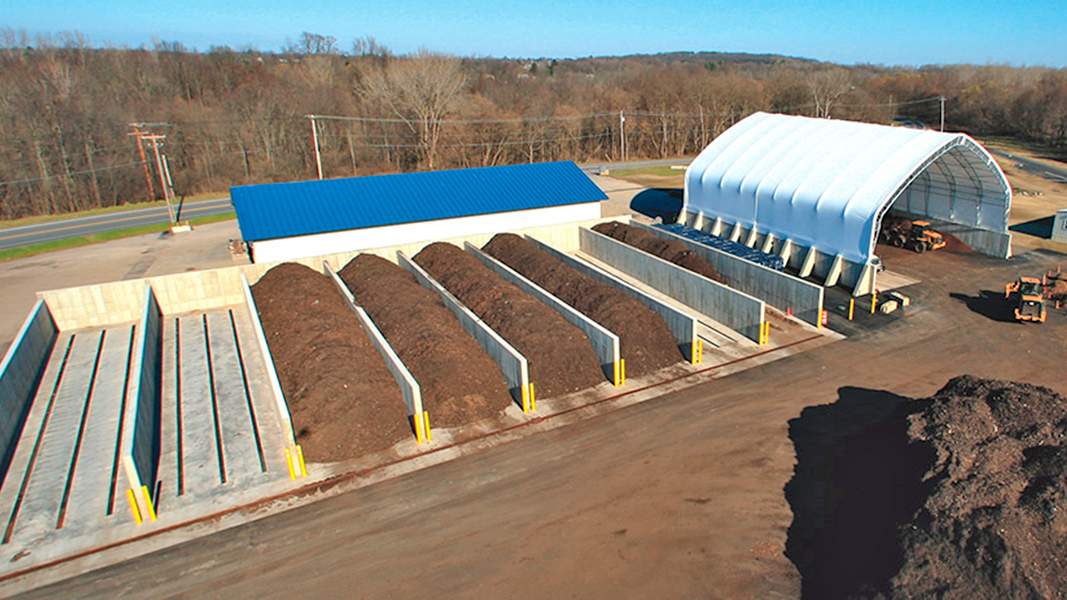Top: Onondaga County (NY) Resource Recovery Agency’s source separated organics composting facility permitted to accept food scraps.
The New York State Department of Environmental Conservation (DEC) announced proposed regulations in late January to implement its new statewide waste reduction initiative that supports food donation and food recycling to help prevent the landfilling of food scraps. The draft regulations would implement the Food Donation and Food Scraps Recycling Act, which goes into effect in January 2022. “The proposed regulations would require composting and the donation of edible food by large food scrap generators to promote an effective reuse of materials otherwise headed for landfills,” said DEC Commissioner Basil Seggos. “Perhaps even more critical now, when so many New York families are struggling with food insecurity during the pandemic, these proposed regulations support initiatives to connect hungry people with edible food and support organizations like Feeding New York State that are working to reduce hunger in our communities.”
The DEC will hold two virtual public hearings on the draft regulations on April 7 (1:00 pm and 6:00 pm EST), and is accepting public comments on the proposal until April 27. The regulations implement the Act’s requirements for all designated food scrap generators to donate excess edible food and send food scraps to an organics recycler if one is available within 25 miles of the generator. DEC’s draft regulations define a food scrap generator as an entity that generates an annual average of two tons of food scraps or more per week at a single location. These entities include, but are not limited to, supermarkets, food service businesses such as restaurants, higher education institutions, hotels, food processors, correctional facilities, and sports or entertainment venues. The proposal exempts New York City, hospitals, nursing homes, adult care facilities, and elementary and secondary schools.
The draft regulations detail requirements to donate excess food and recycle food scraps if an organics facility is available, as well as annual reporting. A temporary waiver provision is included for generators that demonstrate a need to be excluded from certain requirements, such as a lack of food scraps transporters nearby. The proposal also outlines requirements that apply to transporters, transfer facilities, landfills, and combustion facilities to ensure that once the food scraps are separated by the generator, they are ultimately recycled and not disposed. Elements of the proposed regulations include:
Food generation methodology: The department will use proxy calculations, such as number of employees or college students, equated to food scraps generation, to estimate the amount of food scraps generated from a source and will make those calculations available on its website. If proxy calculations are not available or are not appropriate, the department will use other information, such as phone interviews, and publicized research to determine food scraps generation.
Separation of edible food for donation: On or after January 1, 2022, all designated food scraps generators must separate their edible food for donation for human consumption from food scraps designated for recycling or disposal to the maximum extent practicable, as determined by the department using comparable data from similar generators.
Separation of food scraps for recycling: Any designated food scraps generator that is within 25 miles (measured in a straight line) of an organics recycler(s) or an intermediary used prior to recycling such as a regional depackaging facility or a transfer facility, to the extent that the facility has capacity to accept all of the generator’s food scraps based on the department’s yearly estimate of an organic recycler’s capacity, must separate its food scraps from other solid waste. The materials separated will depend on the capabilities of the organics recycler used by the generator. For example, postconsumer food scraps do not have to be collected by the generator unless the organics recycling facility is capable of removing contaminants (plastics, etc.) that are likely to be present with the food scraps. The generator may determine the most efficient and appropriate separation methods for its operation.
Use of on-site recycling systems: If a designated food scraps generator is required to recycle and chooses to use an on-site system, the system must treat at least 80%, by volume, of the food scraps generated annually. If it is less than 80%, the remainder must be sent to an off-site organics recycler with sufficient capacity if one exists within a 25-mile radius of the generator, measured in a straight line. For systems that discharge to the public sewer system, the food scraps generator must obtain approval in writing to utilize the public sewer system for this purpose, including applying for and obtaining any necessary permits or other authorizations.













